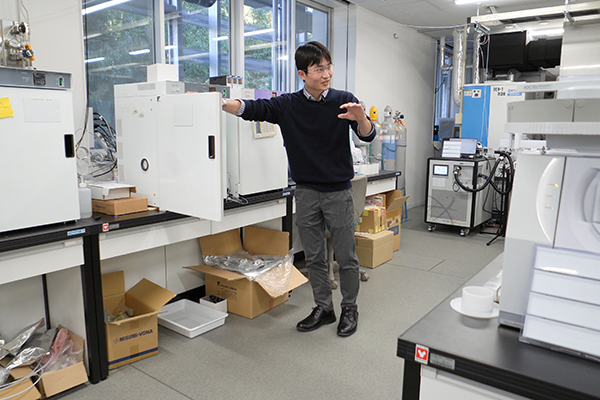ORGANIC ELECTRONICS CHEMISTRY
KATSUHIKO ARIGA LAB.
INTRODUCTION OF LABORATORY
Our research is based on organic chemistry, supramolecular chemistry, and interfacial science. We freely synthesize functional molecules that are often assembled at appropriate interface. For example, synthesized molecular machines are aligned as thin films on water surface, and these molecular machines are operated by hand-like motion of film compression and expansion to catch and release a target molecule. Such molecular machines and insect-like supramolecular assemblies are also transferred on highly sensitive mechanical sensors. Highly sensitive detection of environmentally toxic gasses and super-bio discrimination of amino acids and nucleic acid bases are actually accomplished. We aim to create functional molecular systems that no one have ever prepared.

我々のナノカー

分子を捕まえたり放したりすることができる。

触角分子集合体によるセンサーの開発

MESSAGE
CAN WE CONTROL MOLECULAR MACHINES BY OUR HAND? BIG FINDINGS ARE ALWAYS HIDDEN BEHIND IMPOSSIBLE QUESTIONS.
I want to be different from others, be storage guy, be in minority Group, behave unexpectedly, and work hard like superhuman (but I cannot probably be a smart professor). Last year, Nobel prize of chemistry was given to molecular machines that are operated upon sophisticated molecular designs and are currently by top-level nanotechnology. However, we are trying to operate molecular machines by our hands to make them for everyone’s use. Crazy ideas, catch and release of a molecule by hands and nucleic acid base discrimination much better than DNA by hands, can be done with our secrete interfacial technique.
keyword
Nanomaterials / Supramolecular chemistry / Surface/interfacial properties / Nanomaterials / Capsules / Nanostructures / Biological materials / Carbon / Monolayer / Thermoelectric materials / Capacitors / Material removal / Porous bodies / Differentiation / Liquids / Cells / Interfaces / Hybrid / Polymer micelles / metal oxides / electrochemical catalysts / mesoporous materials / sensors / nanolithography / drug delivery / molecular memory / nanophosphorography / porphyrins / molecular patterns / conjugated oligomers / superhydrophobicity / structural transfer / micro/nano devices / Self-assembly / nanotubes/fullerenes / ultra-thin films / patterns /Oligomers / Reaction and separation engineering / Biomaterials / Environment / Material separation / Tannic acid / Removal / Separation / Adsorption / Carbon nanocage / Mesoporous / Acid dissociation constant / Origin of life / Lipids / Metal ions / Polyprenyl phosphate / Acid dissociation / Bilayer membranes / Molecular evolution / Biological membranes / Origin of lipids / Inhibitors / Signal substances / Logic circuits / Molecular devices / Information amplification / Information conversion / Signal transduction / Enzymes / Artificial receptors / Lipid bilayer membranes / Growth generation / Number of units / lipid structure / surface pressure-area curve / molecular occupied area / air-water interface / dendrimer
PROFILE : Professor Katsuhiko Ariga
1987 Graduated from Tokyo Institute of Technology, master course (1990, PhD)
1987-1992 Assistant professor at Tokyo Institute of Technology
1990-1992 Postdoctoral fellow in University of Texas at Austin
1992-1997 Group leader of JST Supermolecules Project
1998-2001 Associate professor at NaraInstitute of Science and Technology
2001-2003 Group leader of JST Aida Nanospace Project
2004- Group leader of National Institute for Materials Science (since 2007, MANA Principal Investigator)
2017- Professor of University of Tokyo
STUDENT VOICE : TOMOHIRO MURATA
Dr. Ariga is an effective and disciplined researcher. His by discussing with him. In our laboratory, each member has a unique research theme and studies it through thinking outside the box. You can have an invaluable research life in an environment surrounded by many foreign researchers.

NEW MATERIALS AND INTERFACES
Ideas are treasures.






Ariga Katsuhiko Lab.,
Department Of Advanced Materials Science,
Graduate School of Frontier Sciences,
The University of Tokyo
Kashiwanoha 5-1-5,
Kashiwa,Chiba 277-8561, Japan
+81-29-860-4597
ariga.katsuhiko@nims.go.jp
The Goal of Applied Physics
The goal of Applied Physics is to develop a stage = “new material” that can manipulate undeveloped degrees of freedom, to explore unknown phenomena created from that stage and to bring out excellent functions, and to bring out its excellent functions. The purpose is to contribute to the development of human society by elucidating the mechanisms and developing application fields for these phenomena and functions.
AMS (Advanced Materials Science)
Department Office
AMS (Advanced Materials Science),
Graduate School of Frontier Sciences,
The University of Tokyo
Kashiwanoha 5-1-5, Kashiwa, Chiba 277-8561, Japan
Email : ams-office(at)ams.k.u-tokyo.ac.jp
Please change (at) to @.
